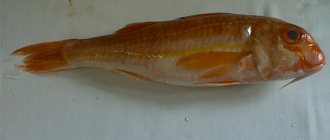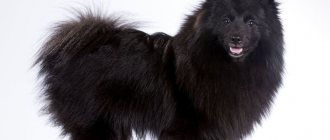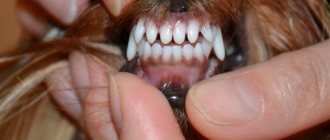According to the standard adopted by the American Kennel Club, the Pomeranian Spitz breed has twelve varieties of coat color. This dwarf dog can satisfy any taste of a sophisticated lover. Black and tan, sable, white, cream, brown – what other shades of wool do Pomeranians have you will learn in this article.
Exhibition figures
If your goal is to participate in exhibitions or breed the breed, then before purchasing a Pomeranian puppy, familiarize yourself with the basics of standard dog colors. The American Kennel Club classifies Pomeranian colors into three open class categories:
- orange, cream, sable;
- black, brown, blue;
- other acceptable colors.
If you are buying a puppy for your family, then choose any coat color you like. But remember that the final shade of the coat will be formed only after the first seasonal molt. Therefore, you can reserve the puppy you like and wait, or trust the experience of the breeder. You can also find out the future color by the color of the fur behind the dog’s ears, but this is not a 100% option.
Let's take a closer look at each of the colors of the Pomeranian Spitz.
Disqualifying faults
RKF admitted a number of serious violations that will lead to disqualification from the exhibition event. These include spots on the coat of any color other than white. The presence of white marks on the tips of the legs or chest is not a fundamental reason to disqualify an animal.
An equally serious violation is a black nose in any type of Spitz except chocolate. The brown one may have a nose that matches the color of the fur.
If the exhibition is held in winter, a lighter nose on an orange, beige or cream Spitz is not considered a disqualifying fault. This is due to the fact that in winter their nose always becomes lighter.
Black shade
The standard imposes its own nuances - a black Pomeranian Spitz has dark skin, a black nose and a black undercoat. Light spots are a defect.
Despite this, the world does not stand still and life constantly makes its own adjustments. Pomeranians brought from different countries, when crossed, produce black puppies with a small amount of light hairs on the undercoat, which do not quite fit the breed standard, but still participate in exhibitions.
In black Pomeranians, the undercoat may become slightly brown before the seasonal shedding due to fading. But over time it gains thickness and turns black.
To prevent your puppy from changing its color over time, ask the breeder if all the dogs in his family were black. Otherwise, there is a risk of tan spots.
Grooming and hygiene
Pomeranians are very fluffy, which means their thick coat needs to be well maintained. Due to the structure of the coat, Pomeranians are not prone to matting, so in normal times the dog should be brushed once a week.
During shedding, your Pomeranian should be brushed at least once every two days. Otherwise, those same fluffy clouds of white, cream or even black will fly around the apartment.
Important! The first molt in puppies begins at 2–3 months and lasts up to a year.
There is no point in bathing your orange one again. Water procedures do not have the best effect on the quality of wool. You should wash your dog only when it gets dirty or before shows. The condition of your pet’s eyes, teeth, and ears should be monitored regularly.
Wipe the eyes with a clean cloth moistened with drinking water. Brush your teeth with a special brush and toothpaste. Clean your ears with a regular ear stick.
Grooming is done to give the thick coat of Pomeranian dogs a beautiful shape. In this case, only the guard hair is cut.
Important! Under no circumstances should the undercoat be cut or shaved, as it is not restored in Pomeranians.
White shade
The white Pomeranian was bred in Japan and over time there are very few pure white dogs left. Breeders have difficulty producing such puppies, since they mostly appear white only at first glance. Cream colors often predominate.
In order for a white Pomeranian to be able to participate in the exhibition, its color must be snow-white. Yellow spots on the ears are a defect.
The white Spitz has the same situation as the black one - all ancestors must be of the same type, any other shade in the line of sires will easily give tan spots over time or the color of the puppy will become cream.
Owners who choose a white dog must be extremely neat and clean.
Origin story
The Pomeranian Spitz breed was developed in Germany, in the Pomerania region, hence the name of the breed. The first Pomeranians are much larger than the current ones, they weighed about 15-20 kg and were used as guard dogs. Their color was white.
In the 19th century, Pomeranian Spitz had already appeared in Russia; they were brought to us from Germany and England. At that time, Spitz were considered an elite breed and only rich representatives of the classes could afford them. Pomeranians were an adornment for beautiful ladies. Gradually, various variations of the breed began to be developed. The dogs differed in size, type, and color. As a result of long breeding, new colors began to appear: red, cream, peach, black.
And later, Spitz dogs turned from large guard dogs into small, decorative dogs. In character, they remained like their ancestors, brave, ready to defend their master to the end.
Sable shade
One of the common colors of the same type is sable. But it can only be called the same type based on genetic criteria. Upon examination, it becomes clear that this shade consists of two colors: the guard hair has a zonal gray tint, and the undercoat can be red, cream or gray.
Some experts agree that this color should be called zonal. Based on this, sable color is divided into three types:
- red sable;
- creamy sable;
- zonal gray.
The main difference between the sable shade is that the muzzle and ears are the same color.
Spitz color standards
The colors of the wool of the German breed and other species are simply amazing in their diversity and unusualness.
These little fluffies always attract the attention of others. Dogs have a rather capricious character, and their restless energy is in full swing. If you decide to buy a Spitz, it is important to make the right choice in favor of a color that is standardized, because some of the colors are still not recognized. For example, according to the standard, a Wolfspitz should only have wolf colors and variations on the theme of gray. Large ones only come in black, brown or white. At the same time, the presence of stains is a non-standard color.
Small dogs have a variety of shades: completely black, white, chocolate, red, cream, marble (zonal gray). In these subspecies, the standard is the presence of two colors, spotting and various rare shades.
Advice. Choose a pet after four months of age, during this period the first molt occurs, and you can see exactly what color the fur coat will be.
All colors of Pomeranian Spitz , which are the standard in the canine association for the breed, are given below with descriptions, names and photographs.
White
Initially, almost all representatives of the breed were snow-white, and only in the 19th century they began to breed dogs of yellow-brown or bright red (orange) color. This became popular among noble nobles, so over time the white color was difficult to find. But breeders were able to protect us from losing such a stunning species.
The main feature of snow-white fur is that according to the standard there should be no inclusions. If you see slight darkening on the ears, most likely, when the molting takes place, the fur will be dark. Also, the presence of black individual hairs on the puppy indicates that dark spots will appear.
When choosing a white Spitz, check his entire pedigree to make sure that all of his ancestors were white. Looking at the parents is not always enough; the pet may show the genes of its grandparents.
Snow white dogs
Black
Coal-black dogs look very impressive. In the sun, their fur shines like a diamond if you provide your pet with proper care and do not cut the fur.
A black Spitz will have this shade not only on the coat, the undercoat and skin should be the same.
Interesting ! Using a black Spitz for mating, you can breed a dog of a different shade.
Small puppies can be brown or slightly brown in color, but after the first shedding the coat becomes a uniform, deep color.
Ginger
There are red and orange Spitz dogs. This standard differs only in color intensity. Puppies are born orange. For this type, the standard is the presence of fur of varying intensity on individual parts of the body: chest, muzzle, paws.
If you want to opt for a red-haired baby, look behind the ears. Most often, when it sheds, the color will be the same.
Red pet
Brown
Chocolate colored dogs are quite an unusual coloring. These dogs have coat shades ranging from light chocolate to deep brown. This standard gives preference to darker and more saturated colors. The color of the eyelids, lips and nose can match the fur coat, which is acceptable according to the standard. The color does not change after molting, so you can choose a baby of the desired color at a young age.
Brown handsome man
Sable
These are two-ton dogs that have light roots and dark hair tips. The colors can be beige, gray and orange of different saturations. Color intensity may vary.
Sable color
Party color
The main feature of this type is the presence of a basic tone and interspersed with other colors. The base is always white, and inclusions can be anything, for example, chocolate, red or black. Most often you can find a black and white Spitz.
It is ideal when the specks are distributed evenly over the animal’s body, and the muzzle is painted symmetrically. This is what is valued at exhibition events. An unsuccessful option is coloring, when there are practically no colored spots. In this situation, it will not be possible to win the exhibition.
Party-color dogs
Spotted
The peculiarity of this color is that the base color can be anything, but the inclusions should not be gray, red or black. The spots should be evenly distributed over the animal's body. Such a Spitz will look advantageous against the background of others, which are much more common, due to its unusual coloring.
Spotted handsome
brindle
The brindle color is a little reminiscent of sable, but the significant difference is the presence of stripes, like a tiger. They are brown, less often orange or black. These dogs look amazing and resemble little tiger cubs.
brindle amazing dog
Black and tan
Black and Tan Spitz have a deep black base tone, and the face, chest and legs can be sable or orange.
This color is recognized almost from birth. There are light spots under the eyes, at the base of the muzzle and on the paws.
Interesting ! An interesting fact is that as a Pomeranian grows older, the tan shade of a Spitz can change and become brighter or redder.
Black and tan puppy
Zone gray
These dogs have an unusual coat that resembles a wolf's, which is why zone gray is often called the wolf color. The fur covering the animal's body is silver-gray. The muzzle and ears are darker, and a clear black outline appears around the eyes. This line from the eyes reaches the dog's ears.
The undercoat can be cream, orange or ash gray. The fur around the neck and shoulders is much lighter than the main shade, the tip of the tail is very dark, almost jet black.
Zone gray color
Cream
It is impossible to determine the shade of a cream Spitz immediately after birth. This color will definitely be visible after the dog sheds for the first time. Most often, such puppies are born snow-white, beige, and sometimes white with yellow spots.
If your dream is to become the owner of a cream pet, carefully study its entire pedigree. These dogs come in two shades: rich cream and cool cream. Saturated is sometimes called warm, while cold is difficult to distinguish from white in appearance.
Cream color is very rare
Blue
Blue Spitz, perhaps the most recognized color standard, is the rarest and has a high price. It’s not just that, in the photo, blue-colored Spitz dogs, just like in life, look amazingly impressive. Merlene (merle) color is sometimes found among this standard, but it is a deviation from the norm.
Due to the combination of gray-blue shades, the animals look very unusual, and due to their rarity, they are prized at exhibition events.
Blue Merle Dog - Expensive Dog
Brown shade
The rare brown color of the Pomeranian is also called chocolate. Like black, this shade can be pure brown or tan due to the light hairs on the undercoat. Dark brown Pomeranians without any spots fit the standard.
The intensity of the chocolate color varies: the dog can be either dark brown or chocolate beige. Pomeranian puppies are a lighter shade of brown than adult dogs.
Spotted
Another interesting color option is spotted. Color spots appear evenly across the base color. They can be black, red or gray. A dog with these inclusions on the undercoat is not one of the common variants. To purchase it, you will need to look for a puppy with this color. However, he will stand out noticeably against the background of dogs with “bored” coat colors.
In general, no matter what shade of coat you personally like (“sable”, gray or “orange”), such a dog will certainly become a member of your family. She is cheerful, active and incredibly playful, so she will appeal to both adults and children. Choose a puppy with the color you like and get a real four-legged friend.
Similar article: History of origin and breed standard of the German Miniature Spitz
Red shade
“Pomeranians” of red color are currently the most famous and numerous.
According to the standard, it is this coloring that allows for lighter shades of some parts of the dog’s body: the muzzle, ears, “panties,” and the tip of the tail. It should visually look as if the wool in these places is slightly faded, that is, the color should differ by no more than half a tone.
Price
Animals with a dominant genome are quite valuable for breeding and are therefore expensive.
Puppy
The average cost of a show class black Spitz puppy starts from 50 thousand rubles, pet class - from 30 thousand rubles.
Nurseries
“Min Herts” - Russia, Kashira; “Nixend” - Russia, Moscow; “Bis Grünen Hof” - Russia, Chelyabinsk; Danube Dwarf Country - Serbia, Belgrade; “Lovely Tail Axi” – Russia.
Zonal gray shade
This color is also called silver. Zone-gray Pomeranian Spitz puppies at birth have a shade very close to black. Gradually, the dog’s undercoat gains thickness, and the color becomes lighter, the “orange” becomes similar to a wolf cub.
The zone-gray color has its own distinct characteristics:
- dark ears;
- dark muzzle;
- “glasses” around the eyes;
- clearly visible eyebrows;
- black end of tail;
- light hair on the undercoat;
- light fur on the forearms;
- light gray fur on the lower part of the tail;
- light gray wool on the fringes.
Cream
A cream-colored German Spitz may not immediately acquire its permanent shade.
Sometimes puppies are born completely white and only after the next molt they become creamy. This is why it is difficult to determine what color of fur a dog will have while he is still small. In addition, cream color can also vary from light tones to the darkest.
Similar article: Peculiarities of shedding and caring for Spitz hair
Black and tan shade
This color of the Pomeranian Spitz is divided into two colors. The base color is black; red spots are usually found on the face, under it, on the paws, and under the tail. The dog's ears and eyes also have red markings.
A dog's tan color can be identified from birth - in puppies, a tan tint is immediately visible on the face, under the eyes and on the paws.
Video “Spitz colors”
From this video you will learn what coat color a Spitz has.
Recommended Posts
Standard height and weight of the Cane Corso breed by month
Weight of a puppy and an adult Labrador by month
Weight and height of a German Shepherd puppy by month
38 best dog breeds for apartments according to reviews from breeders and owners
Description and content of the hunting border terrier
TOP 40 best hunting dog breeds with names, descriptions and photos
So, what should you pay attention to first?
If you decide to professionally breed Pomeranians, when purchasing puppies you should definitely take into account not only the colors of the parents, but also all known relatives of your dogs. Sometimes this is not easy, since foreign breeders often either do not indicate this information in the documents at all (as in Hungary), or, as in the United States of America, the names of the colors accepted in the country do not coincide with the European names. In addition, some confusion arises with the pedigrees of puppies resulting from mixed marriages, in which the color of one dog may be recorded differently. All this creates some difficulties, which, however, are completely solvable with a competent approach.











